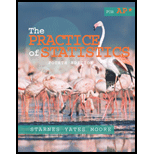
Concept explainers
(a)
To find: The slope of the regression line
(a)
Answer to Problem 3CRE
The regression slope is b = 0.0138
Explanation of Solution
Given:
The regression equation for the bird is:
Calculation:
The equation of the least squares regression line,
Here the slope b of above regression line (0.0138) is the rate at which the predicted response Y changes among the line as the explanatory variable X changes.
Specifically, b is the predicted change in Y when X increases by 1 unit. Here b is positive; this shows if depth increases by 1 meter then dive duration increases by 0.0138 minutes.
Conclusion:
Hence, the slope is: b = 0.0138.
(b)
To find: The length of dive for a depth of 200 meters
(b)
Answer to Problem 3CRE
The length of dive for a depth of 200 meters is 5.45 minutes.
Explanation of Solution
Calculation:
The equation of the least squares regression line,
We are supposed to find the dive the length when the depth is 200 meters. That is, we need to find the predicted value of Y for X = 200 meters.
The predicted value of Y is calculated as follows:
= 2.69+0.0138x200
=5.45
Conclusion:
Hence, this shows that length of dive for a depth of 200 meters is 5.45 minutes.
(c)
To explain: The Y intercept makes any sense
(c)
Answer to Problem 3CRE
Zero meters depth makes no sense.
Explanation of Solution
Calculation:
The Y intercept of above regression line is 2.69
This value is the predicted response, Y when the explanatory variable
In case of penguins diving, zero meters depth makes no sense.
Chapter 3 Solutions
The Practice of Statistics for AP - 4th Edition
Additional Math Textbook Solutions
Introductory Statistics (2nd Edition)
Statistics for Business and Economics (13th Edition)
Intro Stats, Books a la Carte Edition (5th Edition)
Statistics: The Art and Science of Learning from Data (4th Edition)
 MATLAB: An Introduction with ApplicationsStatisticsISBN:9781119256830Author:Amos GilatPublisher:John Wiley & Sons Inc
MATLAB: An Introduction with ApplicationsStatisticsISBN:9781119256830Author:Amos GilatPublisher:John Wiley & Sons Inc Probability and Statistics for Engineering and th...StatisticsISBN:9781305251809Author:Jay L. DevorePublisher:Cengage Learning
Probability and Statistics for Engineering and th...StatisticsISBN:9781305251809Author:Jay L. DevorePublisher:Cengage Learning Statistics for The Behavioral Sciences (MindTap C...StatisticsISBN:9781305504912Author:Frederick J Gravetter, Larry B. WallnauPublisher:Cengage Learning
Statistics for The Behavioral Sciences (MindTap C...StatisticsISBN:9781305504912Author:Frederick J Gravetter, Larry B. WallnauPublisher:Cengage Learning Elementary Statistics: Picturing the World (7th E...StatisticsISBN:9780134683416Author:Ron Larson, Betsy FarberPublisher:PEARSON
Elementary Statistics: Picturing the World (7th E...StatisticsISBN:9780134683416Author:Ron Larson, Betsy FarberPublisher:PEARSON The Basic Practice of StatisticsStatisticsISBN:9781319042578Author:David S. Moore, William I. Notz, Michael A. FlignerPublisher:W. H. Freeman
The Basic Practice of StatisticsStatisticsISBN:9781319042578Author:David S. Moore, William I. Notz, Michael A. FlignerPublisher:W. H. Freeman Introduction to the Practice of StatisticsStatisticsISBN:9781319013387Author:David S. Moore, George P. McCabe, Bruce A. CraigPublisher:W. H. Freeman
Introduction to the Practice of StatisticsStatisticsISBN:9781319013387Author:David S. Moore, George P. McCabe, Bruce A. CraigPublisher:W. H. Freeman





